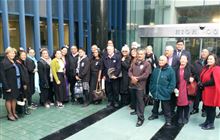Conservation board welcomes seabed mining case victory
Introduction
7 April 2020: The Taranaki-Whanganui Conservation Board has welcomed its latest victory in a long-running court battle to prevent seabed mining off the Taranaki coast.The Taranaki Whanganui Conservation Board (TWCB) has been working with iwi, seafood and other environmental organisations to prevent Trans Tasman Resources from mining 66 square kilometres of South Taranaki Bight seabed for iron ore.
In a judgement handed down this month, the Court of Appeal upheld the concerns of the various groups, in identifying multiple overlapping errors of law in the approach of the Decision Making Committee (DMC) of the Environmental Protection Agency (EPA) when initially granting a marine consent to Trans-Tasman Resources Ltd (TTR) to mine sand in the Taranaki Bight. TWCB Chair Vicky Dombroski says the board worked collectively with other appellants to protect the Taranaki Bight environment, through the consent and court systems in a case which stretches back to 2016.
“This journey has been a long one, and although the Board is delighted with this significant decision, on behalf of the environment, we are mindful the journey may not yet be complete for us,” she says. “That said, we want to take a moment now to acknowledge and thank the multiple people and organisations that have supported us through this.”
The EPA’s DMC initially granted TTR 35-year marine discharge consents to undertake the proposed seabed mining. The decision was appealed, in the High Court, by TWCB, Greenpeace, Forest & Bird, Te Runanga O Ngati Ruanui, Te kahui o Rauru Trust and other organisations representing fisheries and iwi interests.
“We worked closely with several of the other appellants who shared the Conservation Board’s concerns, and are pleased the Court of Appeal agreed the DMC was wrong in how it approached the key matters of concern to us,” Ms Dombroski says.
The three key points in the Court of Appeal judgment for the Conservation Board were:
- The EPA’s DMC failed to assess TTR’s application against the “protect the environment from pollution” purpose in the Exclusive Economic Zone Act.
- The EPA’s DMC not favouring caution, when information from TTR was inadequate or uncertain.
- The EPA’s DMC had not considered whether TTR’s proposal would be inconsistent with environmental “bottom lines” established under the Resource Management Act through the New Zealand Coastal Policy Statement.
“We are also thrilled to note our treaty partner stakeholders also had their ‘existing interests’ confirmed as another error of law on the part of the decision-making committee of the EPA,” Ms Dombroski says.
“TWCB is also very proud to be part of a group of appellants who have tested the EEZ Act and assisted to set precedent for others wanting to undertake extractive activity, like seabed mining, in New Zealand waters.”
Ms Dombroski acknowledged the TWCB’s barrister, James Gardner-Hopkins, for his advice, expertise and patience in pursuing the case on its behalf: “He has been highly professional in explaining technical legal jargon to a Board consisting of mainly laypeople with little experience in the legal system.”
Ms Dombroski says although the TWCB has won this latest and third round in the case, the board’s members were mindful the case may not be at its end.
“That said, we want to take a moment now to acknowledge and thank the multiple people and organisations to have supported us through the journey.”



